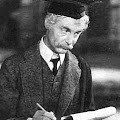
 |
| Rolf Armstrong, Self Portrait, 1914 - pastel on board |
Introducing the languid and oh-so glamourous pin-ups of illustrator, Rolf Armstrong. Vampish, alluring and kitsch, these bedroom-eyed starlets dazzle with their super-saturated colours.
"Born in Seattle in 1899, Rolf Armstrong grew up in the rugged environment of the Pacific Northwest. He moved to Chicago in 1908 and later enrolled at the Art Institute, where he studied for three years under the master draftsman John Vanderpoel. He then went on to New York, where he became a student of Robert Henri. Athletic as well as artistic, Armstrong both boxed and sketched at the New York Athletic Club.
After a trip in 1919 to study art at the Académie Julian in Paris, Armstrong established a studio in Greenwich Village and started to paint Ziegfeld Follies girls. In 1921, he went to Minneapolis-St. Paul to study calendar production at Brown and Bigelow. A perfectionist all his life, Armstrong mastered the technical aspects of modern publishing because he wanted his work to have the same "freshness and beaming color" on paper as on canvas. Not surprisingly he refused to work from photographs, and his search for the perfect model was unending.
During the 1920s and 1930s, Armstrong's work appeared on numberless pieces of sheet music as well as on the front covers of many mainstream theater and film magazines. All the great stars posed for his glamorous portraits – Mary Pickford, Greta Garbo, Marlene Dietrich, Katherine Hepburn. He even persuaded Boris Karloff to pose for him on the set of Frankenstein.
Armstrong's covers for Pictorial Review were largely responsible for the magazine's achieving, by 1926, a circulation of more than two million copies per issue. A year later Armstrong emerged as the best-selling calendar artist at Brown and Bigelow. RCA hired Armstrong in 1930 to paint pin-ups to advertise their products, and by 1933 his popularity was so great that the Thomas D. Murphy Company signed him up to produce a series of ten paintings for their line, an honor shared only by Billy De Vorss
Armstrong maintained a "fantasy mansion" on Little Neck Bay in Bayside, Long Island, complete with a lagoon and sailboats for his friends to enjoy. Because light was so crucial to his work, he often painted his models outdoors in the glow of the setting sun. Employing an extraordinary selection of pastel colors for most of his work, Armstrong also at times utilized charcoal, pencil, and oils.
When asked why he insisted on a live model, Armstrong said: "When I paint, I want the living person in front of me. As I look at her again and again and again while I work, I get a thousand fresh, vivid impressions...all the glow, exuberance, and spontaneous joy that leaps from a young and happy heart".
Armstrong was inspired by the glitter of society and he appreciated beauty in people, cars, furniture, fabrics, and, of course, in art. A collector of swords and antique lances, he built one of the greatest private collections of ancient weapons in America. He died on 22nd February 1960, on the island of Oahu in Hawaii, surrounded by his beloved blue ocean and tropical winds.
Armstrong's artistry was an amalgam of brilliant lighting techniques, magnificent vivid colors, superior craftsmanship, and beautiful subjects – his vivacious, spirited ideals of American femininity." From areaofdesign
Armstrong maintained a "fantasy mansion" on Little Neck Bay in Bayside, Long Island, complete with a lagoon and sailboats for his friends to enjoy. Because light was so crucial to his work, he often painted his models outdoors in the glow of the setting sun. Employing an extraordinary selection of pastel colors for most of his work, Armstrong also at times utilized charcoal, pencil, and oils.
When asked why he insisted on a live model, Armstrong said: "When I paint, I want the living person in front of me. As I look at her again and again and again while I work, I get a thousand fresh, vivid impressions...all the glow, exuberance, and spontaneous joy that leaps from a young and happy heart".
Armstrong was inspired by the glitter of society and he appreciated beauty in people, cars, furniture, fabrics, and, of course, in art. A collector of swords and antique lances, he built one of the greatest private collections of ancient weapons in America. He died on 22nd February 1960, on the island of Oahu in Hawaii, surrounded by his beloved blue ocean and tropical winds.
Armstrong's artistry was an amalgam of brilliant lighting techniques, magnificent vivid colors, superior craftsmanship, and beautiful subjects – his vivacious, spirited ideals of American femininity." From areaofdesign





















Comments
Post a Comment